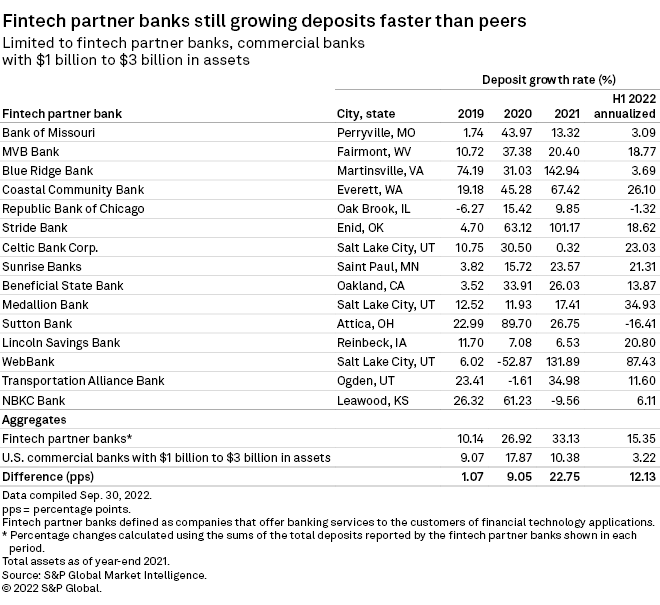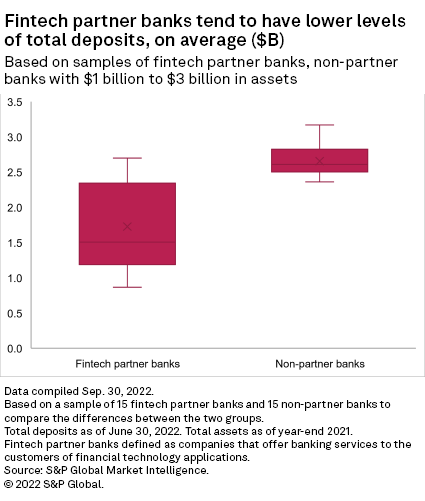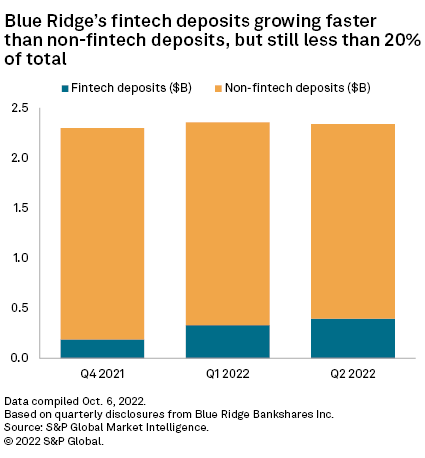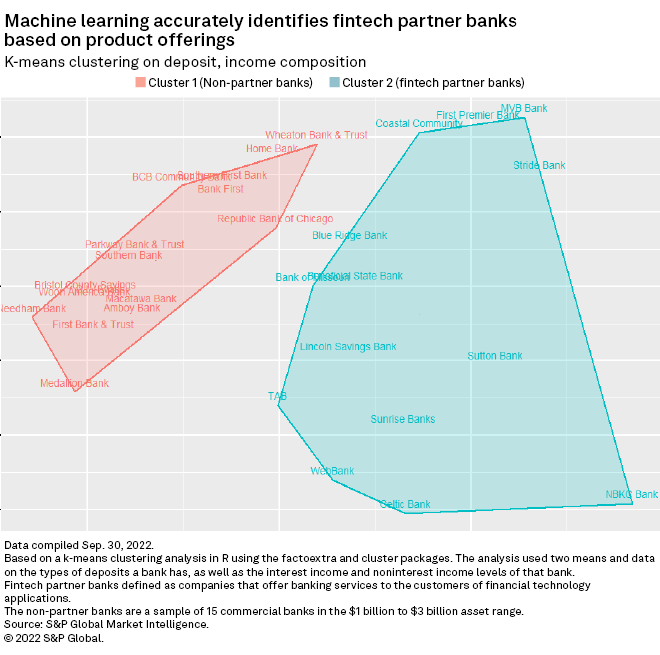S&P Global Offerings
Featured Topics
Featured Products
Events
S&P Global Offerings
Featured Topics
Featured Products
Events
S&P Global Offerings
Featured Topics
Featured Products
Events
Banking & Capital Markets
Economy & Finance
Energy Transition & Sustainability
Technology & Innovation
Podcasts & Newsletters
Banking & Capital Markets
Economy & Finance
Energy Transition & Sustainability
Technology & Innovation
Podcasts & Newsletters
S&P Global Offerings
Featured Topics
Featured Products
Events
Research — 25 Oct, 2022

By Thomas Mason
Introduction
Financial technology companies remain a wellspring of deposits for the banks that partner with them. Of a group of 15 U.S. partner banks in the $1 billion to $3 billion asset range, about 10 are on track for double-digit increases in total deposits in 2022, far outpacing U.S. commercial banks of similar size.
We define a "partner bank" to be an FDIC member bank that offers services, such as credit and debit cards or personal loans, to the customers of financial technology applications. Users interact with the fintech app on the front end, but their accounts are with the partner bank on the back end. This is often referred to as banking-as-a-service.



Community banks saw an influx of deposits amid the pandemic, but growth will be harder to come by this year and next, per S&P Global Market Intelligence's U.S. Community Bank Projections. The latest forecast shows deposits decreasing 1.8% in 2022 and 0.5% in 2023.
The partner banks seem an exception to this overall trend. WebBank, for one, is on pace to grow deposits 87% in 2022, based on its rate from the first half of the year annualized. In the second quarter of 2022, WebBank launched U.S. credit cards for buy-now-pay-later provider Klarna Holding AB (publ) and cryptocurrency exchange Gemini Trust Co. LLC that had waitlists of more than 1 million and 500,000, respectively. PayPal Holdings Inc. also unveiled a new buy-now-pay-later product, PayPal Pay Monthly, in partnership with WebBank on June 15.
But while partner banks are growing deposits quickly, they had, on average, lower aggregate levels of deposits than peers as of June 30. The partner bank group's average deposit level was $1.73 billion, versus an average of $2.65 billion for a group of 15 banks in the same asset range.

The difference was statistically significant, judging by a standard statistical analysis F-test and a t-test at an alpha level of 0.01. This is valuable context for the deposit growth data since it is easier to log a higher percentage off a smaller base. It might also be an indication that account sizes are smaller.
On average, the partner banks had larger numbers of accounts and therefore smaller average balances in those accounts. Looking at accounts of $250,000 or less, NBKC Bank had more than 990,000 as of June 30, which meant an average account size of roughly $450. Lincoln Savings Bank and Medallion Bank each had more than 1 million accounts, with average account sizes of roughly $830 and $1,000, respectively. But results varied, sometimes substantially. As the boxplot shows, partner banks have a wide range of deposit levels compared to non-partner banks. Their deposit levels also tended to be more volatile from quarter to quarter, as measured by standard deviation.
Part of the challenge of classifying partner banks is that banking-as-a-service might only be a portion of the bank's business. For instance, Blue Ridge Bankshares Inc. provides a breakout in quarterly filings submitted to the SEC, which showed that fintech deposits accounted for only 17% of total deposits as of June 30. But Blue Ridge's results certainly underscored the trend of banking-as-a-service being a deposit growth driver: Fintech deposits more than doubled from the fourth quarter of 2021 to the second quarter of 2022, whereas non-fintech deposits fell about 8%.

Even if partner banks do not focus exclusively on banking-as-a-service, they tend to have some features that set them apart from peers. A high ratio of noninterest income to total income is a potential clue that a bank does banking-as-a-service, as is the aforementioned number of deposit accounts relative to total assets. A partner bank might also have a large ratio of transaction deposits to total deposits.
A machine can even be trained to spot the differences: A k-means classification algorithm, used in machine learning, separated the partner banks from the non-partner banks with 90% accuracy. The algorithm groups data points together into clusters that have similar mean values across specified features. For our analysis, we used two clusters and data on deposit composition and noninterest income.

The algorithm makes a few mistakes, however. We would consider Republic Bank of Chicago and the aforementioned Medallion Bank to be partner banks.
This article was published by S&P Global Market Intelligence and not by S&P Global Ratings, which is a separately managed division of S&P Global.
Podcast
